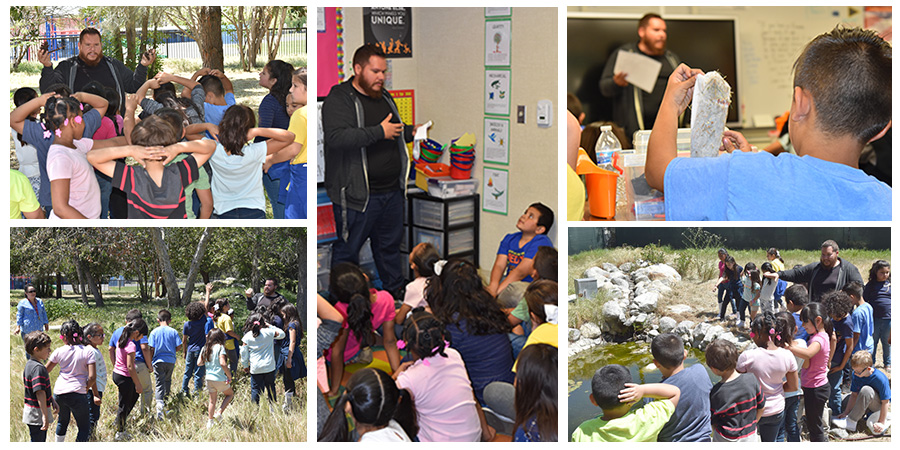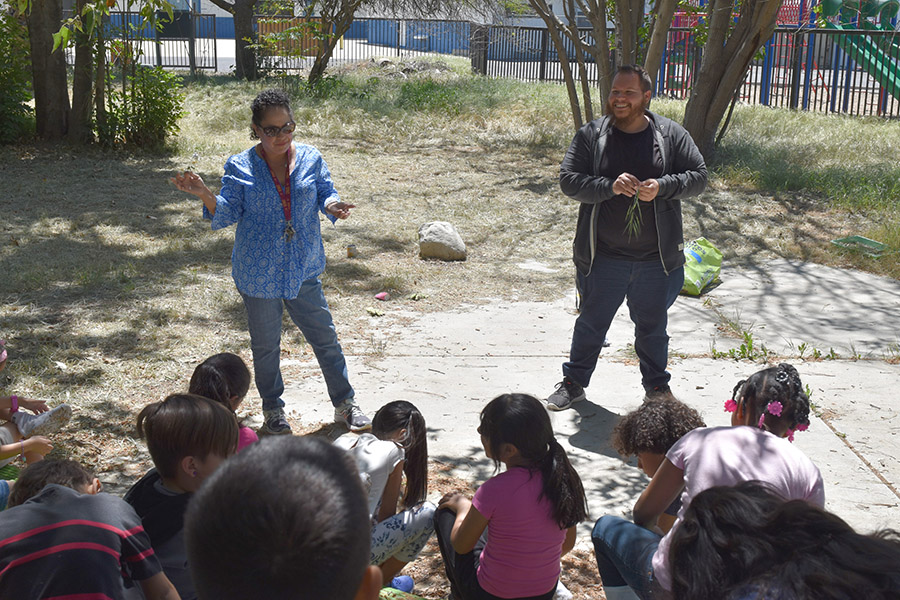An Interest in Science Takes Root in This Garden
Thanks to the Prete Fellowships

By fourth grade (age 10) elementary school students have already decided whether they like science and feel they’re smart enough to pursue a career in the sciences. That’s what recent research tells us and yet science isn’t a state tested subject until the fifth grade. The Center for Excellence in Mathematics and Science Teaching (CEMaST) at Cal Poly Pomona is making a difference in early science and math teaching through partnerships with local schools. One program the Center manages is the Prete Fellowships which places Cal Poly students with the Pomona Unified School District. Currently the Fellowships are only at Kellogg Polytechnic Elementary School and are the result of collaboration between Nicole Wickler, Research Director from CEMaST and Kellogg Principal Rabia Minhas.
The Prete Fellowships are funded by the Ernest Prete, Jr. Foundation which currently provides funding for 15 Fellows at Kellogg Polytechnic Elementary School. The CPP students provide up to 10 hours a week of support to the teachers which includes using an existing garden at the school to integrate urban gardening lessons into the curriculum. They learn about gardening, nutrition, and how certain crops complement each other and affect the soil. The lessons educate students about their families’ health and about broader concepts of sustainability in their communities and the world.
Prete Fellow Victor Celaya, a Kinesiology and Health Promotion major, already knew he wanted to be a teacher. It’s not a requirement of the Fellowship though some Fellows find they have a calling to teach after participating in the program. Victor, who wants to teach physical education is finding creative ways to incorporate PE into Ms. Peña’s second grade science curriculum. One method was to have students play a field game that represented the ocean’s ecosystem, another was having students act out different methods by which seeds are dispersed.
In the garden the second graders learned how seeds can travel from one place to another, hitching a ride on animals. They got to see first-hand how this works. Celaya had them put a sock over one of their shoes and then took the class for a visit to the garden. When they returned they could see all the interesting things their socks picked up and draw pictures of the seeds and plants they’d collected. On the surface it looks a lot like play but the exercise includes testing the hypothesis that seeds can hitchhike on animals, data collection and analysis.
One of the things that surprised Celaya the most is the amount of academic rigor that second graders can handle. “They’ve been able to keep up with every concept I’ve presented,” he said. “I thought I would need to make things simpler but they can use the scientific method and take data.” He confides that one of the most important things he’s learned is to present concepts as a question. “It causes them to really think about the concept.”
One thing that makes the Prete Fellowships so successful is the support and preparation that the Fellows receive. They receive training from Nicole Wickler, Research Director at CEMaST, and the principal of Kellogg Polytechnic Rabia Minhas who makes regular trips to Cal Poly to assist in that training. Fellows are given the tools they need to develop lesson plans based on Next Generation Science Standards (NGSS) and California Common Core State Standards (CCST).
The other thing that supports the success of the program is the working relationships Fellows have with the elementary teachers. They’re not just assigned a class, rather, they spend time observing all grade levels and select the teachers they’d most like to work with. Based on teacher feedback, every teacher now has a Fellow as opposed to just one per grade level. This allows the Fellow and teacher to develop a stronger working relationship.
Lastly, the Fellows don’t begin by presenting their science lesson plans, instead they’re given time to tutor students in individual and small group settings which allows them to develop rapport with the students. For Victor Celaya this meant tutoring reading at the “Accelerated Reader Resort.” The resort consisted of beach chairs and an umbrella in an outdoor tutoring environment. It was such a popular destination for students that they were competing to get into the resort. It’s that sort of creative approach to teaching that made Celaya decide to choose Ms. Peña’s 2nd grade class.
Ms. Peña and Principal Minhas are glad he made that choice because his one-on-one tutoring helped increase one student’s reading ability by two grade levels. The student, who struggled with reading at a first grade level, is now reading at the 3rd grade level, and more importantly, this student who once had no interest in reading is now an avid reader. The remarkable progress the student has made is a direct result of Prete Fellow Victor Celaya’s efforts. Minhas and Pena couldn’t be happier and they’re enthusiastic about the prospect of the program continuing.
The Prete Fellowships are a win-win for Kellogg Polytechnic and Cal Poly Pomona. Teachers say the enthusiasm of the Fellows reinvigorates their teaching while providing role models for students. “The college students are like rock stars in the eyes of our elementary students and their presence shows them that men, women, and minorities can become scientists,” Minhas said. “The program gives Cal Poly students an opportunity to make a profound impact on the lives of these students while gaining valuable teaching experience and developing adaptability and soft skills that will help them throughout their careers.”

